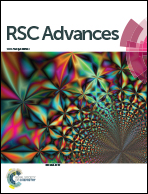The mechanism for CO2 reduction over Fe-modified Cu(100) surfaces with thermodynamics and kinetics: a DFT study†
Abstract
The adsorption, activation and reduction of CO2 over Fex/Cu(100) (x = 1–9) surfaces were examined by density functional theory. The most stable structure of CO2 adsorption on the Fex/Cu(100) surface was realized. The electronic structure analysis showed that the doped Fe improved the adsorption, activation and reduction of CO2 on the pure Cu(100) surface. From the perspective of thermodynamics and kinetics, the Fe4/Cu(100) surface acted as a potential catalyst to decompose CO2 into CO with a barrier of 32.8 kJ mol−1. Meanwhile, the first principle molecular dynamics (FPMD) analysis indicated that the decomposition of the C–O1 bond of CO2 on the Fe4/Cu(100) surface was only observed from 350 K to 450 K under a CO2 partial pressure from 0 atm to 10 atm. Furthermore, the results of FPMD analysis revealed that CO2 would rather decompose than hydrogenate when CO2 and H co-adsorbed on the Fe4/Cu(100) surface.



 Please wait while we load your content...
Please wait while we load your content...